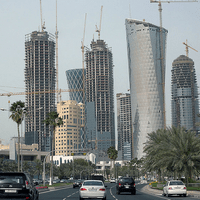The decision by FIFA, soccer's world governing body, to award the 2022 World Cup to Qatar was momentous on many levels, but historic on one key score: Never before has a global sporting event of such stature been awarded to a country so clearly stuck in a "bad neighborhood" like the Persian Gulf, where the potential for large-scale regional war between now and 2022 is far from theoretical. FIFA's decision was bold alright, but it also signals the international community's growing faith in what Gulf Cooperation Council countries like Qatar have achieved in promoting economic and network connectivity with the outside world. You could say that the 2022 World Cup is globalization's way of returning the favor.
Going back to my 2003 Esquire article, "The Pentagon's New Map," and my 2004 book of the same name, I've argued that you can divide the world into two general categories: a Functioning Core of countries with high or rapidly increasing connectivity with globalization in all its forms, and the Non-Integrated Gap, where most -- but not every -- country is situated in regions lacking such deep connectivity. The logic is simple enough: The more that countries connect to the outside world, the more they suffer its many rules that circumscribe behavior. Once a country passes a threshold of deep connectivity, it gets out of the war-and-defense business and into the policing-and-security business.
Geographically, the Core now consists of the "old core" West of North America, Western Europe and industrialized Asia, plus the "new core" created by the fall of the Soviet Union and the rising economic pillars of Asia and the South. The Gap remains centered around the equator, stretching from the Caribbean Rim and Andean north of South America on to Africa and Southwest Asia, up to the Caucasus and Central Asia, and wrapping around much of Southeast Asia.

